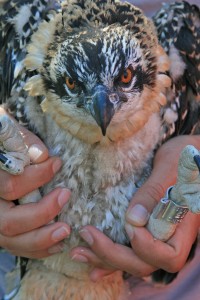Cfwep.Org is proud to partner with the Avian Science Center at the University of Montana. Through this partnership, Cfwep.Org and the Avian Science Center have reached thousands of area students through the Bird’s Eye View program. The partnership was a natural evolution as both programs focus on reaching children and adults, utilizing the Clark Fork clean-up and on-going research as a platform for education.
The primary goal of the Avian Science Center’s programs is to provide families living within the Upper Clark Fork River Basin a “bird’s-eye view” of the effects of past mining activities and of current restoration projects aimed at repairing mining- related damages. Participants are invited to observe birds up close at the banding stations, learn about Montana’s riparian birds, and interact directly with biologists collecting scientific data on bird communities – thus it represents an opportunity for citizens to take part in the process of science. This program is unique because it takes place during the summer months and targets both children and adults. The Cfwep.Org core programming takes place during the school year and illustrates studying the history leading to the damages, the riparian habitat, water chemistry, and macroinvertebrates. The partnership with the Avian Science Center enriches the Cfwep.Org core programming by illustrating the effects of the restoration within animal communities.
The Avian Science Center and Cfwep.Org also partner with Project Osprey at the University of Montana. Project Osprey educates participants about Ospreys and river health, while examining heavy metal blood-levels found in osprey chicks along the Clark Fork River. The researchers have published a detailed inventory of mercury and other contaminants in ospreys in the Clark Fork River Basin and are now focusing on the long-term effects of these contaminants on ospreys and the ecosystem in general. Another focus of Project Osprey is to educate area ranchers and citizens to the dangers of bailing twine for nesting ospreys. Because the bailing twine is bright and appears to be good nesting material, the ospreys will pick up the twine scattered throughout fields. This twine becomes harmful when the chicks hatch and are beginning to fledge. Often, chicks become entangled in the twine resulting in a chick death rate of approximately 10%.
Both Project Osprey and the Bird’s Eye View Program offer public education events throughout the summer. Project Osprey has live cameras on several nests throughout the Clark Fork, which can be viewed at http://www.cas.umt.edu/geosciences/faculty/langner/Osprey/index.htm. Additionally, Project Osprey has a Facebook page that is updated frequently by the project team.
To following are the Bird’s Eye View banding schedule. The public is invited to join the scientists for any of the banding dates.
• MPG Ranch near Florence
• Valley of the Moon Nature Trail
on Rock Creek
• Grant-Kohrs Ranch NHS in
Deer Lodge
• Mt. Haggin WMA near Anaconda
What can you expect to see & learn
by visiting our bird banding station?
• Observe birds “in the hand” and find
out what a “brood patch” is.
• Learn why biologists capture and
band birds and what kind of data
we collect.
• Gain bird ID skills and learn a
few common bird songs.
• Find out why riparian areas are
so important to birds.
• Learn the history of mining activities
in the Upper Clark Fork Basin and
the effect those activities had on
bird communities.
Visitors should plan to arrive at either 7:00 am or 9:00 am in order to participate in the program. For more information about this program or to arrange a group visit, contact Megan Fylling (megan.fylling@mso.umt.edu) or Sharon Fuller (Sharon.fuller@mso.umt.edu).
Please keep in mind that these programs are weather dependent – if the forecast is for rain or high winds, we may have to cancel – contact Megan or Sharon at 243-2035 for an update.
Visitors should wear shoes and clothes appropriate for hiking near riparian woodlands & consider bringing snacks or a lunch, as well as water, sunscreen, a hat, and bug repellent (the mosquitoes can be quite numerous!) Bring binoculars if you have them and a camera if you’d like – this unique “bird-in-the-hand” situation creates nice photo opportunities. More information about this programis available at: http://avianscience.dbs.umt.edu/projects/bird_banding.php


